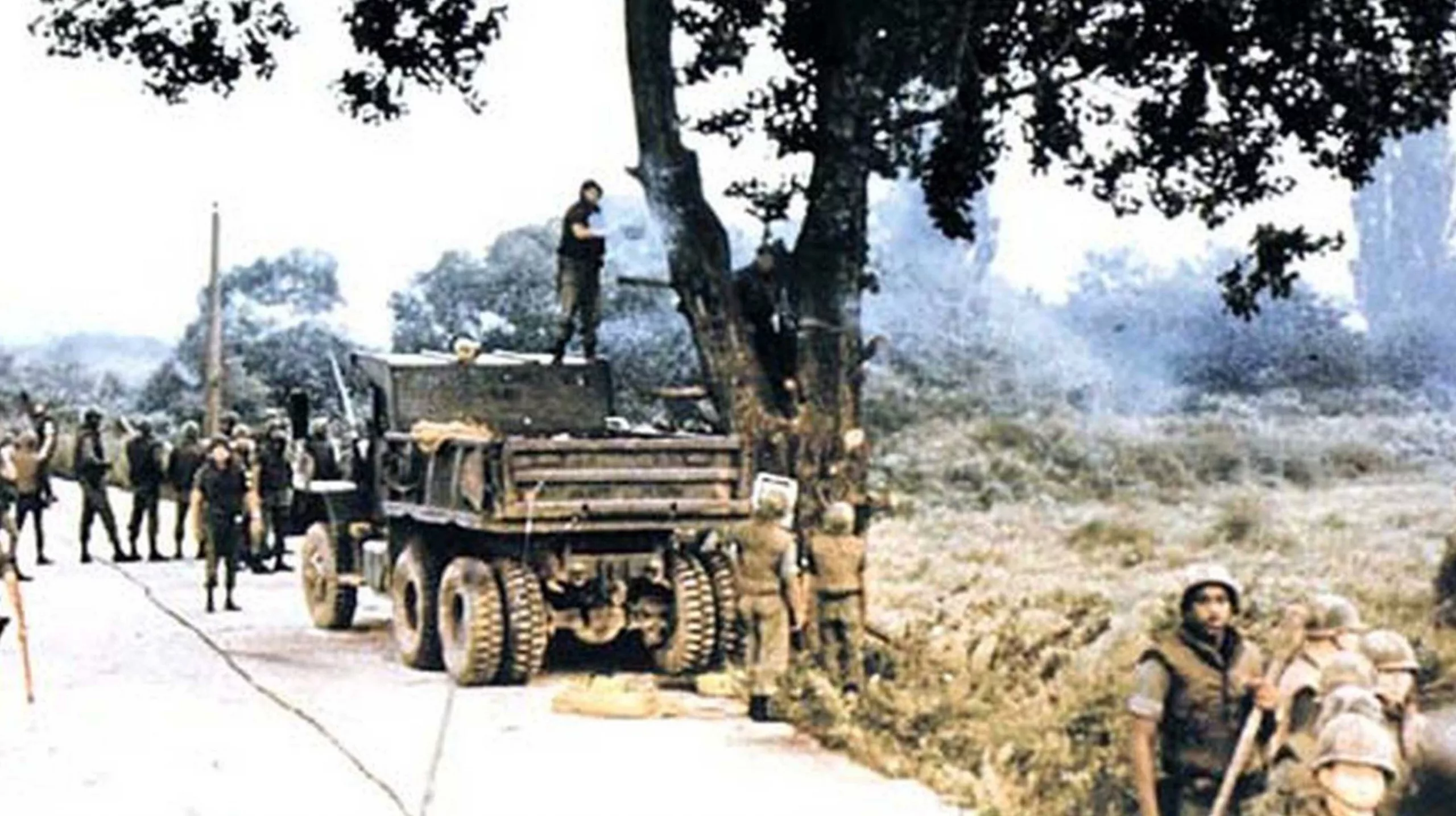In the annals of military history, few events highlight the fragility of peace and the potential for conflict as vividly as Operation Paul Bunyan. This little-known but dramatic confrontation between the United States and North Korea took place in August 1976, following the brutal murder of two U.S. Army officers in the Korean Demilitarized Zone (DMZ). What began as a routine tree-trimming operation escalated into a tense military standoff that nearly ignited another war on the Korean Peninsula.
The crisis underscored the delicate balance of power in one of the most heavily militarized regions on Earth. It also demonstrated how a seemingly minor event could escalate into a major geopolitical flashpoint. The episode was a testament to the strategic use of overwhelming force as a deterrent, showcasing the United States’ ability to project power without directly engaging in combat.
This article explores the background, events, and aftermath of one of the most bizarre and dangerous episodes of the Cold War, analyzing how it shaped military policies and reinforced the ongoing tensions between North and South Korea.
The Incident: The Axe Murder in the DMZ
Background Tensions
By the mid-1970s, the Korean Peninsula remained a volatile flashpoint in the Cold War. The Korean War (1950–1953) had ended in an armistice rather than a peace treaty, leaving North and South Korea in a perpetual state of hostility. The DMZ, established as a buffer zone, was frequently the site of armed confrontations, espionage, and provocations by both sides.
The Joint Security Area (JSA), located within the DMZ, was supposed to allow both North and South Korean forces to operate with minimal confrontation. However, tensions remained high, and even minor disputes had the potential to spiral into larger conflicts. The poplar tree near the Bridge of No Return had been a longstanding source of tension, with North Korean forces using it to obstruct the visibility of United Nations Command (UNC) checkpoints.
The Tree-Trimming Operation
On August 18, 1976, a team of U.S. and South Korean soldiers, under orders from the United Nations Command (UNC), was sent to trim the large poplar tree. The goal was to clear the line of sight between UNC observation posts, improving security for allied forces stationed in the area.
As the work began, a group of North Korean soldiers, led by Captain Kim Jong-chul, arrived and demanded that the Americans and South Koreans stop immediately. The U.S. personnel, following protocol, ignored the demand and continued their work. Suddenly, the North Korean troops attacked without warning. Using axes, clubs, and fists, they launched a violent assault on the team.
The brutality of the attack was staggering. Captain Arthur Bonifas was bludgeoned to death on the spot, while First Lieutenant Mark Barrett attempted to escape but was caught and fatally beaten. Several other U.S. and South Korean personnel suffered serious injuries before they were able to retreat. The entire episode was captured on camera, further inflaming tensions between the U.S. and North Korea.
Operation Paul Bunyan: America’s Show of Force
Immediate Response
The murder of two American officers triggered an immediate and furious response from the U.S. military and political leadership. President Gerald Ford, along with senior Pentagon officials, approved Operation Paul Bunyan, a large-scale demonstration of military strength designed to send an unequivocal message to North Korea.
The mission had two objectives:
- To safely and decisively remove the poplar tree without interference.
- To showcase overwhelming force in such a way that North Korea would be deterred from further aggression.
Unlike a retaliatory strike, which could have escalated into full-scale war, Operation Paul Bunyan sought to intimidate North Korea into submission through a meticulously planned and executed show of strength.
The Execution of the Operation
On August 21, 1976, just three days after the axe murders, U.S. and South Korean forces mobilized in one of the largest peacetime military operations on the Korean Peninsula. The scale of the operation was unprecedented:
- A convoy of 23 U.S. and South Korean military vehicles, escorted by heavily armed troops, arrived at the tree site.
- 60 combat engineers armed with chainsaws, protected by dozens of heavily armed infantrymen, were assigned to remove the tree.
- A strike force of over 800 troops, including Special Forces units, Army Rangers, and marines, were placed on high alert nearby.
- B-52 Stratofortress bombers flew overhead, accompanied by F-4 Phantom fighter jets, sending a chilling warning to Pyongyang.
- U.S. aircraft carriers and battleships took up strategic positions off the Korean coast, ready to engage at a moment’s notice.
- Over 12,000 troops throughout South Korea were placed on maximum alert, prepared for full-scale hostilities if North Korea retaliated.
Despite the overwhelming display of force, North Korean forces did not interfere. The tree was cut down in under 45 minutes, and the operation concluded without further bloodshed.
Aftermath and Legacy
Avoiding War
Operation Paul Bunyan successfully de-escalated the crisis without leading to direct military confrontation. The operation’s psychological impact on North Korea was profound, reinforcing the U.S. commitment to defending South Korea while making it clear that future provocations would be met with overwhelming force. This calculated show of military strength not only deterred further aggression but also served as a reminder of the devastating consequences that could follow any hostile action by North Korea.
In the days following the operation, intelligence reports suggested a significant shift in North Korean military posture, with a noticeable decrease in aggressive behavior along the DMZ. Additionally, diplomatic channels observed an unusual silence from Pyongyang, indicating that the regime was reassessing its position in response to the overwhelming force displayed by the U.S. and South Korea.
Shortly after the operation, North Korean leader Kim Il-sung issued an unprecedented statement expressing “regret” for the attack—an extremely rare diplomatic concession from Pyongyang. While the wording of the statement carefully avoided direct responsibility, it marked one of the few instances in which North Korea acknowledged a provocation had led to international consequences. The North Koreans also agreed to future procedural changes in the Joint Security Area, reducing the likelihood of similar violent confrontations. This incident reinforced the importance of vigilance and strategic deterrence in maintaining stability on the Korean Peninsula, highlighting how measured but forceful responses could prevent escalation while asserting dominance in a high-stakes geopolitical landscape.
Long-Term Impact
While the crisis ended without further bloodshed, it underscored the persistent volatility of the Korean Peninsula and the ever-present risks of escalation in a region fraught with historical tensions. The DMZ remains one of the most militarized borders in the world, with both sides maintaining a heavy military presence, bristling with troops, artillery, and strategic defenses that serve as a constant reminder of the unresolved conflict. The event also set a precedent for how the U.S. would respond to North Korean provocations, emphasizing deterrence through strength, careful military planning, and the importance of maintaining a strategic advantage in an unpredictable theater of operations.
Moreover, the episode served as a stark reminder that even seemingly minor incidents—such as a tree-trimming operation—could have global implications, drawing the attention of the international community to the fragile nature of security in the region. The confrontation demonstrated how a rapid and overwhelming display of military force could be wielded effectively to prevent war without direct engagement. Operation Paul Bunyan became a textbook case for military strategy, illustrating how the projection of overwhelming force could be used as a deterrent without resorting to direct combat, influencing not just future U.S. military operations on the peninsula but also broader Cold War-era conflict management policies.
The psychological impact of Operation Paul Bunyan rippled far beyond the Korean Peninsula. It reinforced the necessity of measured, calculated military responses in the face of aggression and underscored the delicate balance between intimidation and outright confrontation. The operation remains a crucial lesson in crisis management, showcasing the role of force projection as a tool for maintaining peace under high-stakes conditions. As tensions between North and South Korea continue into the modern era, the principles demonstrated in Operation Paul Bunyan serve as a lasting framework for dealing with provocation, emphasizing preparedness, strategic dominance, and the necessity of maintaining diplomatic and military leverage in the face of persistent threats.
Conclusion
Operation Paul Bunyan remains one of the most dramatic and carefully orchestrated displays of military force during the Cold War. It illustrated the fine line between peace and war on the Korean Peninsula and emphasized the importance of decisive yet measured responses to aggression. Though it is often overshadowed by larger Cold War conflicts, its lessons on deterrence, military strategy, and crisis management continue to be relevant in today’s geopolitical landscape.
This remarkable episode serves as a powerful case study in crisis management, showcasing how a carefully calculated show of strength can prevent war while maintaining a position of power and control. It remains an enduring testament to the effectiveness of military deterrence in the face of unpredictable adversaries.




